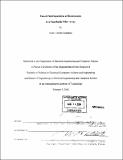| dc.contributor.advisor | Jongyoon Han. | en_US |
| dc.contributor.author | Reyes González, Noel I. (Noel Iván) | en_US |
| dc.contributor.other | Massachusetts Institute of Technology. Dept. of Electrical Engineering and Computer Science. | en_US |
| dc.date.accessioned | 2007-04-03T17:09:02Z | |
| dc.date.available | 2007-04-03T17:09:02Z | |
| dc.date.issued | 2006 | en_US |
| dc.identifier.uri | http://hdl.handle.net/1721.1/37076 | |
| dc.description | Thesis (M. Eng. and S.B.)--Massachusetts Institute of Technology, Dept. of Electrical Engineering and Computer Science, 2006. | en_US |
| dc.description | "February 3, 2006." | en_US |
| dc.description | Includes bibliographical references (leaf 42). | en_US |
| dc.description.abstract | In this work, pulsed electric fields are introduced as a means to enhance separation efficiency of biomolecules in a nanofluidic filter array channel. Separation under pulsed fields was tested using PBR322 DNA, Lambda Hind III DNA, and a sample containing three SDS denatured proteins. Pulsed fields are divided into long pulse and short pulse regimes, depending on how long the duration of the higher electric field pulse is compared to the average trapping time of a molecule in a single nanofluidic filter. It was found that under long pulse fields, the separation selectivity cannot be enhanced since the difference in velocity between two different molecules will always be a weighted average of the velocity at the high and low field levels of the pulsed field. On the other hand, application of pulsed fields in the short pulse regime yielded more promising results. After the pulse duration became comparable to the average trapping time of migrating molecules, the average velocity of molecules decreased with a reduction in the pulse duration. Certain bands within a sample were slowed down more than others by appropriately choosing the pulse duration, therefore resulting in increased selectivity and higher separation efficiency. | en_US |
| dc.description.abstract | (cont.) For PBR322 DNA, separation resolution of up to 2.54 was obtained in under 15 minutes when the pulse duration was decreased down to 5ms. Novel experiments are proposed to achieve separation through band selective elution and bidirectional transport. A probabilistic model based on the binomial distribution is also proposed as a method to estimate the average velocity of molecules in the short pulse regime. | en_US |
| dc.description.statementofresponsibility | by Noel I. Reyes González. | en_US |
| dc.format.extent | 42 leaves | en_US |
| dc.language.iso | eng | en_US |
| dc.publisher | Massachusetts Institute of Technology | en_US |
| dc.rights | M.I.T. theses are protected by copyright. They may be viewed from this source for any purpose, but reproduction or distribution in any format is prohibited without written permission. See provided URL for inquiries about permission. | en_US |
| dc.rights.uri | http://dspace.mit.edu/handle/1721.1/7582 | |
| dc.subject | Electrical Engineering and Computer Science. | en_US |
| dc.title | Pulsed field separation of biomolecules in a nanofluidic filter array | en_US |
| dc.type | Thesis | en_US |
| dc.description.degree | M.Eng.and S.B. | en_US |
| dc.contributor.department | Massachusetts Institute of Technology. Department of Electrical Engineering and Computer Science | |
| dc.identifier.oclc | 83279351 | en_US |
